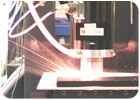
The Laser Applications Laboratory at Argonne National Laboratory, along with a group of collaborators, is examining the feasibility of adapting high-power laser technology to drilling applications. The initial phase is designed to establish a scientific basis for developing a commercial laser drilling system, and determine the level of gas industry interest in pursuing future research. If drilling with lasers ultimately proves viable, it could be the most radical change in drilling technology in the last century.
It was at the turn of the 20th century when rotary drilling supplanted cable tool drilling as the petroleum industry's standard method for reaching oil and gas formations. While major improvements have occurred since then, the basic mechanical drilling method has remained essentially the same.
Using lasers to bore a hole offers an entirely new approach. The novel drilling system would transfer light energy from lasers on the surface, down a borehole by a fiber optic bundle, to a series of lenses that would direct the laser light to the rock face.
Researchers believe that state-of-the-art lasers have the potential to penetrate rock at 10 times to 100 times faster than conventional boring technologies – a huge benefit in reducing the high costs of operating a drill rig. Reducing the time a drill rig remains on site can lower costs and make previously uneconomic gas or oil deposits commercially attractive.
Laser systems now can provide more than enough power to cut rock. Because the laser head does not contact the rock, there is no need to stop drilling to replace a mechanical bit. Moreover, researchers believe that lasers have the ability to melt the rock in a way that creates a ceramic sheath in the wellbore, eliminating the expense of buying and setting steel well casing. A laser system also could contain a variety of downhole sensors – including visual imaging systems – that could communicate with the surface through the fiber optic cabling.
While the lure of laser drilling has been its speed, one major drawback has been the large amounts of energy experts assumed would be required. A Gas Research Institute study indicated, however, that conventional wisdom – much of it based on 20-year-old calculations – may have significantly overestimated the energy required to break, melt or vaporize rock.
One of the primary objectives of the new study has been to obtain much more precise measurements of the energy requirements needed to transmit light from surface lasers down a borehole with enough power to bore through rocks as much as 20,000 feet or more below the surface.
Another aspect of the study will be to determine if sending the laser light in sharp pulses, rather than as a continuous stream, could further increase the rate of rock penetration. Pulsed lasers have been used for better performance in cutting steel, for example. It may be likely that the pulsing action will flex and break the physical bonds between the rock grains, boosting the cutting effectiveness.
A third aspect of the new project will be to determine if lasers can be used in the presence of drilling fluids. The technical challenge will be to determine whether too much laser energy is expended to clear away the fluid where the drilling is occurring.
ND
Report Abusive Comment